
Hotepsekhemwy is the Horus name of an early Egyptian king who was the founder of the Second Dynasty of Egypt. The exact length of his reign is not known; the Turin canon suggests an improbable 95 years while the ancient Egyptian historian Manetho reports that the reign of "Boëthôs" lasted for 38 years. Egyptologists consider both statements to be misinterpretations or exaggerations. They credit Hotepsekhemwy with either a 25- or a 29-year rule.

Qa'a was the last king of the First Dynasty of Egypt. He reigned for 33 years at the end of the 30th century BC.

Iry-Hor or Ro was a predynastic pharaoh of Upper Egypt during the 32nd century BC. Iry-Hor's existence was debated, with the Egyptologist Toby Wilkinson contesting the reading and signification of his name. However, continuing excavations at Abydos in the 1980s and 1990s and the discovery in 2012 of an inscription of Iry-Hor in the Sinai confirmed his existence. Iry-Hor is the earliest ruler of Egypt known by name and is sometimes cited as the earliest-living historical person known by name.

Nebra or Raneb is the Horus name of the second early Egyptian king of the 2nd Dynasty. The exact length of his reign is unknown since the Turin canon is damaged and the year accounts are lost. Manetho suggests that Nebra's reign lasted 39 years, but Egyptologists question Manetho's view as a misinterpretation or exaggeration of information that was available to him. They credit Nebra with either a 10- or 14-year rule.
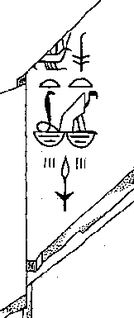
Weneg, also known as Weneg-Nebty, is the throne name of an early Egyptian king, who ruled during the Second Dynasty. Although his chronological position is clear to Egyptologists, it is unclear for how long King Weneg ruled. It is also unclear as to which of the archaeologically identified Horus-kings corresponds to Weneg.

Senedj was an early Egyptian king (pharaoh), who may have ruled during the 2nd Dynasty. His historical standing remains uncertain. His name is included in the kinglists of the Ramesside era, although it is written in different ways: While the Abydos King List imitates the archaic form, the Royal Canon of Turin and the Saqqara King List form the name with the hieroglyphic sign of a plucked goose.
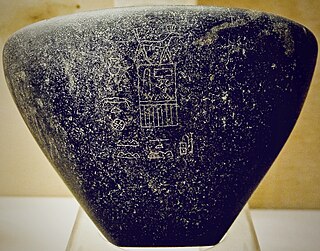
Seth-Peribsen is the serekh name of an early Egyptian monarch (pharaoh), who ruled during the Second Dynasty of Egypt. His chronological position within this dynasty is unknown and it is disputed who ruled both before and after him. The duration of his reign is also unknown.
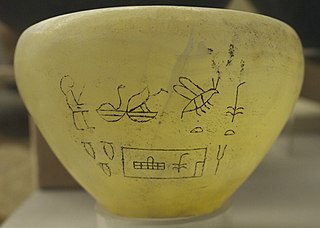
Semerkhet is the Horus name of an early Egyptian king who ruled during the First Dynasty. This ruler became known through a tragic legend handed down by the historian Manetho, who reported that a calamity of some sort occurred during Semerkhet's reign. The archaeological records seem to support the view that Semerkhet had a difficult time as king and some early archaeologists even questioned the legitimacy of Semerkhet's succession to the Egyptian throne.

Sekhemib-Perenma'at, is the Horus name of an early Egyptian king who ruled during the 2nd Dynasty. Similar to his predecessor, successor or co-ruler Seth-Peribsen, Sekhemib is contemporarily well attested in archaeological records, but he does not appear in any posthumous document. The exact length of his reign is unknown and his burial site has yet to be found.
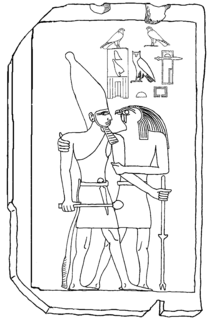
Qahedjet could be the Horus name of an ancient Egyptian king (pharaoh), who may have ruled during the 3rd Dynasty or could be a voluntarily archaistic representation of Thutmose III. Since the only artifact attesting to the ruler and his name is a small stela made of polished limestone of uncertain origin and authenticity, Egyptologists are discussing the chronological position and historical figure of Qahedjet.
Weneg was a sky and death deity from ancient Egyptian religion, who was said to protect the earth and her inhabitants against the arrival of the "great chaos".

The Horus name is the oldest known and used crest of ancient Egyptian rulers. It belongs to the "great five names" of an Egyptian pharaoh. However, modern Egyptologists and linguists are starting to prefer the more neutral term: the "serekh name". This is because not every pharaoh placed the falcon, which symbolizes the deity Horus, atop his serekh.
Djeseretnebti is possibly the name of an ancient Egyptian queen. Since this name appears without any queen‘s title, Egyptologists dispute the true meaning and reading of this name.
Khenthap was allegedly a queen of Ancient Egypt. She is said to have lived during the 1st Dynasty. Her historical figure is very obscure, since there are no contemporary sources for her name. She appears only once in a much later inscription.
Betrest was a royal queen of Ancient Egypt. She lived during the First Dynasty.

Horus Sa was a possible early Egyptian pharaoh who may have reigned during the Second or Third Dynasty of Egypt. His existence is disputed, as is the meaning of the artifacts that have been interpreted as confirming his existence.
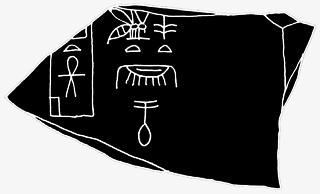
The prenomen, cartouche name or throne name of ancient Egypt was one of the five royal names of pharaohs. The first pharaoh to have a Sedge and Bee name was Den during the First Dynasty.
Akhetaa was an ancient Egyptian high official during the mid to late 3rd Dynasty. He is mostly known for his tomb inscriptions, which refer to various seldom used titles as well as to the shadowy king Nebka, in whose cult Akhetaa served.
Hedju Hor was a ruler in northern Egypt from the Predynastic Period. His existence is controversial. The name Hedhu-Hor means The maces of Horus.
Jochem Kahl is a German Egyptologist.













